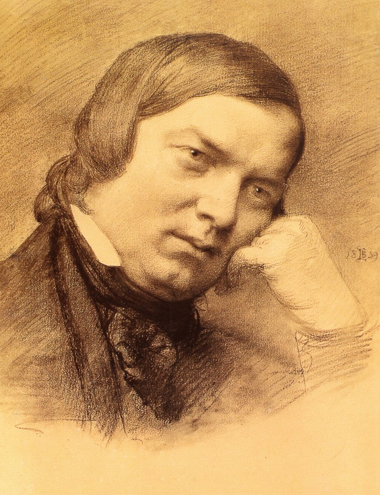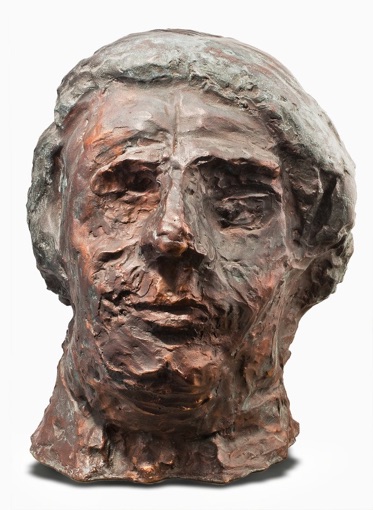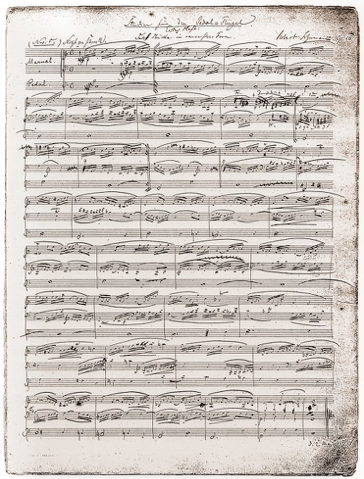“Miss no opportunity to practice on the organ; there is no instrument that takes such immediate revenge on the impure and the careless, in composition as well as in the playing, as the organ.”
Robert Schumann

Robert Schuhmann,
charcoal drawing by Eduard Bendemann, 1859
(after an daguerreotype of 1850)
Robert Schumann and the Organ
The years 1809 to 1811 might be called the beginning of musical High Romanticism: Four grand representatives of that era were born within a short period – Felix Mendelssohn-Bartholdy, Robert Schumann, Frédéric Chopin and Franz Liszt.
The close friendship between Robert Schumann and Felix Mendelssohn-Bartholdy, whose musical interest and appraisal not only covered their era, but also the period of the 17th and 18th century – especially the compositions of J. S. Bach – contributed strongly to keeping traditions alive. Both composers had additionally studied organ from the beginning of their musical education on the piano, both were familiar with Bach’s organ compositions since youth – both were fascinated by his composing style and appreciated Bach immensely.
At the age of 11, Mendelssohn wrote his first organ composition; small and medium pieces followed throughout his life until the highlight of the Six Organ Sonatas op. 65, which was published 1845 – two years before Mendelssohn’s death – almost at the same time in England, Germany and Italy. Mendelssohn was one of the best known and most successful concert organist of his era – after a brilliant organ recital in the St. Paul’s Cathedral, London (1837) he was actually referred to as the greatest Organist who had ever played in London.
Schumann’s enthusiasm for Baroque music is firstly documented in his writings: At only 24 years, he founded the “Neue Zeitschrift für Musik” in 1834 – this journal has been continued ever since, being today’s oldest journal of music. In this publicistic forum Schumann, who was a master of sound as well as of language, pleaded insistently for the support of Baroque music and encouraged all young musical people to deal with and to study it.
Time and again, the influence of his friend Mendelssohn becomes distinctly noticeable: Schumann admired his ability to combine – as composer and as interpreter – classical (baroque) tradition with the means of musical expression of the 19th century. For example, he enthusiastically acclaimed the only organ recital including works of J. S. Bach Mendelssohn had played in Leipzig, Germany (1840) in his journal of music where he also provided a detailed and glowing review of the 6 Organ Sonatas.
The complete works of Robert Schumann show a true representative of the Romantic era who comes to full expression without the corset of strict composition or formal schemes such as the classic sonata. The word, the poetry of his time was an inspiration not only for his extensive song oeuvre – most notably in many piano works he conveys the spirit and contents of literary originals by means of his musical language.

Robert Schuhmann,
bust by Alfred Hrdlicka 2003,
casting Alfred Zöttl
(Wienbibliothek im Rathaus – Musiksammlung)
(Photo: Clemens Kneringer)
Robert and also Clara Schumann tried to counteract Schumann’s artistic crisis, which first emerged in 1844 with depressive and lethargic behaviour, by dealing intensively with strict composition based on the study of Friedrich Wilhelm Marpurg’s “Abhandlung von der Fuge” (“Treatise on the Fugue”) and Luigi Cherubini’s “Theorie des Contrapunktes und der Fuge” (“A Course of Counterpoint and Fugue”).
Schumann’s personal transcription of J.S. Bach’s “Kunst der Fuge” (“The Art of Fugue”) demonstrates the intensity of his occupation with Bach’s composing style during this years. In April 1845 Schumann leased a pedalier to his piano–as some kind of substitute for the organ and for exercising. Thus several polyphonic compositions were the fruit of working on the pedal piano.
The first pieces in this polyphonic style were the “Studien für Pedalflügel. Sechs Stücke in canonischer Form Opus 56” (“Studies for Pedal Piano. Six Pieces in canonic form Op. 56”).
This typical romantic mood pieces – except the first study which reminds of J. S. Bach’s Inventions – build a cycle which can be characterized by Schumann’s description of Mendelssohn’s “Präludien und Fugen für Klavier” (“Preludes and Fugues for Piano”), Opus 35:
“Es sind nicht allein Fugen, mit dem Kopf und nach dem Rezept gearbeitet, sondern Musikstücke, dem Geist entsprungen and nach Dichterweise ausgeführt.” (“These are not only fugues created in the brain by means of a formula but musical pieces, emerged from the spirit and designed like poetic rhymes.”)
Schumann’s “Studies” sound wonderful on the organ despite the pianistic composition and dynamic signatures which were unusual for the organ music of the middle of the 19th century but rather comply with the organ style at the beginning of the 20th century. More or less the same applies for the “Vier Skizzen für Pedalflügel” (“Four Sketches for Pedal Piano”) Opus 58.
Here the polyphonic elements are in no way predominant, instead the sketches anticipate the genre of the mood piece later gaining popularity through compositions of Max Reger and Siegfried Karg-Elert. Schumann’s one and only genuine organ pieces are “Sechs Fugen über den Namen BACH für Orgel oder Pedalflügel” (“Six Fugues on the Name of BACH for Organ or Pedal Piano”) Opus 60.
This work kept Schumann intermittently from April to September 1845. (The studies and sketches were also published during this month.) Schumann’s comments on his Opus 60 show how close this work was to his heart, and how much he was engaged in the study of Bach’s fugue composition.
“Die meisten der Bach’schen Fugen sind aber Charakterstücke höchster Art, zum Teil wahrhaft poetische Gebilde, deren jedes seinen eigenen Ausdruck, seine besonderen Lichter and Schatten verlangt.” (“The majority of Bach’s fugues are mood pieces of the highest degree, partly indeed poetic structures of which each one requires it’s own expression, it’s special lights and shadows. “)
A consequence thereof is Schumann’s comment on the fugue compositions of Mendelssohn: “Jedenfalls bleibt immer die die beste Fuge, die das Publikum etwa für einen Straußchen Walzer hält, mit andren Worten, wo das künstliche Wurzelwerk wie das einer Blume überdeckt ist, dass wir nur die Blume sehen.” (“Anyway, this will always be the best fugue the public for instance regards as a waltz by Strauß – in other words, where the artificial rootage is covered like the roots of a flower so that we can see just the flower.”)
In his “BACH-Fugen” Schumann appears as master of the counterpoint in the variety of polyphonic composition which culminates in the Double Fugue at the end of the cycle. At the same time these fugues are expressive compositions Schumann himself described as “Charakterstücke, aber im strengen Stil” (“Mood pieces, but in strict style”).
Wonderful examples are the virtuosic second fugue, the meditative third fugue, the witty, scherzo-ish fifth fugue and the brilliant, symphonic final of the sixth fugue. Moreover, especially in the first, forth and sixth fugue there is evidence of influence of the baroque composition style.
Although there had been some fugues written on the Name BACH before Schumann’s Opus 60, and other important pieces on BACH were produced during the Romantic era of the second half of the century – for instance the works of Liszt and Reger – Schumann’s Fugues Opus 60 deserve a place of honour within the long series of BACH compositions.
Thus a letter of Schumann to his London publisher Whistling in 1846 in which he wrote about his Opus 60:
“Es ist dies eine Arbeit, an der ich das ganze vorige Jahr gearbeitet, um es in etwa des hohen Namens, den es trägt, würdig zu machen, eine Arbeit, von der ich glaube, dass sie meine anderen vielleicht am längsten überleben wird.” (“This is an opus I was working on the entire last year to make it a nearly worthy representative of it’s great name, an opus that I believe will possibly outlive my other works for the longest time.”)
Helga Scholz-Michelitsch
Translated by Susanne Weber

(Robert-Schumann-Haus, Zwickau)
References:
Robert Schumann: Schriften. Bd 2. – 51914
Hans Joachim Moser: Orgelromantik. – 1961
Klaus Peter Richter: Die stockende Zeit – Aspekte Schumannschen Kontrapunktes in den Kompositionen op. 56, 58 und 60 für Pedalflügel oder Orgel. In: Robert Schumann.1. – 1981. Musik-Konzepte. Sonderband.
Hans Fagius: The Organ Works of Mendelssohn and Schumann and their Link to the Classical Tradition. In: Proceedings of the Göteborg International Organ Academy 1994. – 1995.
Ernst Burger: Robert Schumann. Eine Lebenschronik in Bildern und Dokumenten. – 1999.
Burkhard Meischein: „Nach Dichterweise ausgeführt“. Robert Schumanns Werke für Orgel oder Pedalklavier. In: Studien zur Orgelmusik . 1. – Zur deutschen Orgelmusik des 19. Jahrhunderts. – 6 2003.
